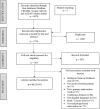The Application of Technological Intervention for Stroke Rehabilitation in Southeast Asia: A Scoping Review With Stakeholders' Consultation
- PMID: 35198531
- PMCID: PMC8858807
- DOI: 10.3389/fpubh.2021.783565
The Application of Technological Intervention for Stroke Rehabilitation in Southeast Asia: A Scoping Review With Stakeholders' Consultation
Abstract
Background: The technological intervention is considered as an adjunct to the conventional therapies applied in the rehabilitation session. In most high-income countries, technology has been widely used in assisting stroke survivors to undergo their treatments. However, technology use is still lacking in Southeast Asia, especially in middle- and low-income countries. This scoping review identifies and summarizes the technologies and related gaps available in Southeast Asia pertaining to stroke rehabilitation.
Methods: The JBI manual for evidence synthesis was used to conduct a scoping study. Until September 2021, an electronic search was performed using four databases (Medline, CINAHL, Scopus, ASEAN Citation Index). Only the studies that were carried out in Southeast Asia were chosen.
Results: Forty-one articles were chosen in the final review from 6,873 articles found during the initial search. Most of the studies reported the implementation of technological intervention combined with conventional therapies in stroke rehabilitation. Advanced and simple technologies were found such as robotics, virtual reality, telerehabilitation, motion capture, assistive devices, and mobility training from Singapore, Thailand, Malaysia, and Indonesia. The majority of the studies show that technological interventions can enhance the recovery period of stroke survivors. The consultation session suggested that the technological interventions should facilitate the needs of the survivors, caregivers, and practitioners during the rehabilitation.
Conclusions: The integration of technology into conventional therapies has shown a positive outcome and show significant improvement during stroke recovery. Future studies are recommended to investigate the potential of home-based technological intervention and lower extremities.
Keywords: Southeast Asia; cerebrovascular accident; developed countries; developing countries; low-middle income countries; rehabilitation; technological intervention.
Copyright © 2022 Selamat, Che Me, Ahmad Ainuddin, Salim, Ramli and Romli.
Conflict of interest statement
The authors declare that the research was conducted in the absence of any commercial or financial relationships that could be construed as a potential conflict of interest.
Similar articles
-
Stroke Rehabilitation for Falls and Risk of Falls in Southeast Asia: A Scoping Review With Stakeholders' Consultation.Front Public Health. 2021 Mar 3;9:611793. doi: 10.3389/fpubh.2021.611793. eCollection 2021. Front Public Health. 2021. PMID: 33748063 Free PMC article.
-
Post-stroke cognitive impairment and dementia research in Southeast Asia: A scoping review.Asian J Psychiatr. 2025 May;107:104460. doi: 10.1016/j.ajp.2025.104460. Epub 2025 Mar 23. Asian J Psychiatr. 2025. PMID: 40157215
-
Falls amongst older people in Southeast Asia: a scoping review.Public Health. 2017 Apr;145:96-112. doi: 10.1016/j.puhe.2016.12.035. Epub 2017 Jan 21. Public Health. 2017. PMID: 28359399
-
Population policies in Southeast Asia and Australia: the international relevance of domestic affairs.J Aust Popul Assoc. 1984 Spring;1:109-20. doi: 10.1007/BF03029405. J Aust Popul Assoc. 1984. PMID: 12267174
-
Research landscape on 3D printing applications in healthcare within Southeast Asian countries: a systematic scoping review protocol.BMJ Open. 2022 Dec 13;12(12):e065546. doi: 10.1136/bmjopen-2022-065546. BMJ Open. 2022. PMID: 36523224 Free PMC article.
Cited by
-
Quantitative Evaluation of Postural SmartVest's Multisensory Feedback for Affordable Smartphone-Based Post-Stroke Motor Rehabilitation.Int J Environ Res Public Health. 2025 Jun 28;22(7):1034. doi: 10.3390/ijerph22071034. Int J Environ Res Public Health. 2025. PMID: 40724102 Free PMC article.
-
Feasibility of Smartphone-Based Exercise Training Integrated with Functional Electrical Stimulation After Stroke (SETS): A Preliminary Study.Sensors (Basel). 2025 Feb 19;25(4):1254. doi: 10.3390/s25041254. Sensors (Basel). 2025. PMID: 40006483 Free PMC article.
-
Poststroke eHealth Technologies-Based Rehabilitation for Upper Limb Recovery: Systematic Review.J Med Internet Res. 2025 Mar 4;27:e57957. doi: 10.2196/57957. J Med Internet Res. 2025. PMID: 40053744 Free PMC article.
-
Experiences and needs of the caregivers of stroke survivors in Malaysia-A phenomenological exploration.Front Neurol. 2022 Sep 23;13:996620. doi: 10.3389/fneur.2022.996620. eCollection 2022. Front Neurol. 2022. PMID: 36212650 Free PMC article.
-
Views of Service Users, Their Family or Carers, and Health Care Professionals on Telerehabilitation for People With Neurological Conditions in Ghana: Qualitative Study.JMIR Mhealth Uhealth. 2024 Mar 27;12:e49501. doi: 10.2196/49501. JMIR Mhealth Uhealth. 2024. PMID: 38536218 Free PMC article.
References
-
- Ying CY, Harith S, Ahmad A, Mukhali HB. Prevalence, risk factors and secondary prevention of stroke recurrence in eight countries from South, East and Southeast Asia: a scoping review. Med J Malaysia. (2018) 73:90–9. - PubMed
-
- WHO Global Health Estimates. WHO. (2018). Available online at: http://www.who.int/healthinfo/global_burden_disease/en/ (accessed March 12, 2021).
Publication types
MeSH terms
LinkOut - more resources
Full Text Sources
Medical


